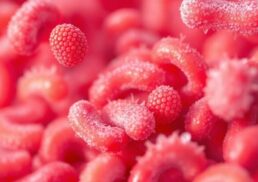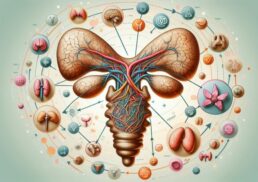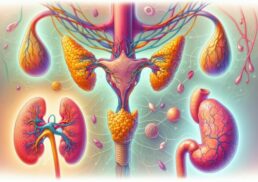Have you ever wondered why certain foods seem to trigger allergy-like symptoms, or why your seasonal allergies seem to worsen after enjoying a glass of red wine? The answer may lie in a common compound called histamine. In this blog post, we’ll explore the fascinating world of histamine and its role in the immune system, allergic reactions, and histamine intolerance. By the end, you’ll have a better understanding of how histamine affects your body, and how to manage its impact on your health.
Table of Contents
Key Takeaways
Histamine is a complex compound that plays an important role in the immune system and has four receptors.
Allergic reactions are caused by histamine binding to its receptors, leading to various symptoms. Medications can be used for management of allergies as well as avoidance of allergens.
A low histamine diet focusing on fresh produce and avoiding processed meats, seafoods and fermented foods can help manage histamine intolerance or allergy symptoms effectively.
Understanding Histamine

Histamine is a biogenic amine synthesized from L-histidine, a vital component in regulating bodily functions, playing a particularly important role in the immune system and inflammatory response. This compound is produced by white blood cells, such as mast cells and basophils, in response to allergens. To maintain balance within the body, histamine is metabolized through two primary pathways: histamine-N-methyltransferase and diamine oxidase. These pathways work together to regulate histamine levels, preventing an overabundance that may cause allergy symptoms.
The complexity of histamine’s function extends far beyond its role in allergic reactions. This versatile compound interacts with four distinct histamine receptors, each with its own unique role in the body. Once we comprehend these receptors and their influence on our immune system, it becomes easier to decode the intricacies of allergies, histamine intolerance, and devise strategies to manage these issues.
Histamine’s Role in the Immune System
Histamine is crucial to the immune system’s defense mechanisms. It is released by mast cells and basophils in response to allergens, providing a vital contribution to the immune response. In fact, only basophils and mast cells are capable of producing and retaining considerable amounts of histamine in granules. Mast cells are a type of white blood cell which can be found in connective tissues around the body. Basophils, on the other hand, are another type of white blood cells which are present in the bloodstream. Both mast cells and basophils play a significant role in mast cell-mediated allergy and histamine release.
Comprehending the role of histamine in the immune system allows us to better understand the symptoms and conditions resulting from its dysfunction. When histamine is released in response to allergens, it can cause a variety of symptoms, such as itching, swelling, and difficulty breathing, which are characteristic of allergic reactions. Recognizing the role of histamine in the immune system can help us better manage these symptoms and improve our overall health.
The Four Histamine Receptors
The four histamine receptors (H1, H2, H3, and H4) each have unique functions and are involved in various physiological processes. H1 receptors are widely distributed in our body. They can be found not only in neurons, but also in smooth muscle cells of airways and blood vessels. Activation of H1 receptors results in sneezing, nasal congestion, and a runny nose, commonly experienced during allergic reactions.
H2 receptors have an extensive presence in the body. They are located in the cells of the stomach that are responsible for gastric acid secretion, as well as smooth muscle and heart cells. H3 and H4 receptors also play crucial roles in the body. H3 receptors are involved in blood-brain barrier function and regulate the release of histamine and various neurotransmitters, such as dopamine, norepinephrine, and acetylcholine.
H4 histamine receptors have been identified as potential drug targets for therapeutic use in conditions such as allergic rhinitis, chronic pruritus, and asthma. Understanding these receptors’ functions allows us to grasp the role of histamine in our bodies better and devise targeted treatment strategies for histamine-related conditions.
Allergic Reactions and Histamine

As a key player in allergic reactions, histamine is responsible for causing allergy symptoms such as itching, swelling, and redness. Allergic reactions occur when the immune system overreacts to a substance, referred to as an allergen, producing Immunoglobulin E (IgE) antibodies which bind to cells that secrete chemicals, thus initiating an inflammatory response. This response can cause symptoms such as itching, swelling, and difficulty breathing, all of which are driven by histamine’s effect on vascular permeability and smooth muscle contraction.
A deeper exploration into the mechanism of allergic reactions and various methods of symptom management provides a clearer understanding of these complex reactions.
Mechanism of Allergic Reactions
Allergic reactions are triggered when histamine binds to its receptors, causing inflammation and other symptoms such as itching, swelling, and redness. The immune system’s role in allergic reactions involves the production of Immunoglobulin E (IgE) antibodies, which bind to cells that secrete chemicals, initiating an inflammatory response. This response can manifest in various ways, from mild symptoms like sneezing and itching to more severe reactions like anaphylaxis.
A clear understanding of how allergic reactions work is paramount in managing symptoms and avoiding potential allergens. By recognizing the role of histamine and its receptors in the immune response, we can better identify potential triggers and develop strategies for minimizing exposure to allergens and managing symptoms.
Managing Allergic Reactions
Antihistamines and other medications can help manage allergic reactions by blocking histamine’s effects on the body. Some common medications used to manage allergic reactions include:
Antihistamines: These medications impede the effects of histamine by obstructing its receptors, inhibiting histamine from binding to them and inducing an allergic reaction. This can help alleviate symptoms such as itching, swelling, and changes in blood pressure.
Corticosteroids: These medications reduce inflammation and can be used to manage allergic reactions.
Epinephrine: This medication is used to treat severe allergic reactions.
Effective management of allergic reactions requires following healthcare providers’ medication instructions and being aware of possible side effects. Additionally, identifying and avoiding allergens is a fundamental aspect of managing allergic reactions, as avoiding triggers can prevent the immune system from overreacting and producing symptoms.
Understanding histamine’s role in allergic reactions and applying suitable treatment strategies enables us to manage our symptoms and maintain our general health more effectively.
Histamine Intolerance
Histamine intolerance is a condition where an individual has an elevated level of histamine in their body, and their body is unable to effectively metabolize it. This can lead to symptoms similar to an allergic reaction, as the immune system overreacts to the presence of histamine. The precise causes of histamine intolerance remain unclear; however, it is hypothesized to be associated with an imbalance in the enzymes responsible for metabolizing histamine in the body.
A comprehensive understanding of histamine intolerance can be achieved by examining its symptoms, causes, diagnosis, and available treatment options.
Symptoms and Causes
Histamine intolerance can manifest in various ways, with symptoms ranging from digestive issues and skin problems to respiratory symptoms, headaches, fatigue, sleep disturbances, anxiety, and irritability. The potential causes of histamine intolerance are still not fully understood, but it is thought that enzyme deficiency, gut health issues, histamine-rich foods, medications, and histamine release from allergic reactions or medical conditions may be responsible.
Awareness of the symptoms and potential causes of histamine intolerance assists individuals in identifying whether they might be affected by this condition. By recognizing the signs of histamine intolerance and addressing potential triggers, individuals can work with their healthcare providers to develop a treatment plan and improve their quality of life.
Diagnosis and Treatment
The diagnosis of histamine intolerance is determined by taking into account the patient’s medical history, physical examination, and laboratory tests. Once a diagnosis has been made, treatment options for histamine intolerance may include following a low histamine diet, taking antihistamines, and other medications as prescribed.
A low histamine diet involves abstaining from foods high in histamine, such as fermented foods, processed meats, and seafood. By following a low histamine diet, individuals with histamine intolerance can help manage their symptoms and reduce the impact of histamine on their health.
Collaborating closely with a healthcare provider will enable those affected by histamine intolerance to devise a personalized treatment plan that caters to their unique needs and enhances their overall well-being.
For more info, visit Understanding Histamine Intolerance.
Foods High in Histamine
Certain foods are particularly high in histamine and should be avoided by those with histamine intolerance or allergies. Some of the most common high-histamine foods include fermented foods, processed meats, and seafood. Awareness of which foods to avoid and making informed dietary choices can help individuals manage their histamine levels effectively and minimize the risk of allergy symptoms or histamine intolerance.
A detailed analysis of each high-histamine food type and discussion of strategies to minimize histamine exposure will be beneficial.
Fermented Foods
Fermented foods, such as sauerkraut and yogurt, can be high in histamine due to the fermentation process, which involves the breakdown of sugars and starches in the food by microorganisms into either alcohol or acids. As a result, the bacteria and yeast used in the fermentation process produce histamine as a by-product, leading to elevated histamine levels in these foods. Examples of other fermented foods include:
Kimchi
Kefir
Miso
Tempeh
Kombucha
Lowering histamine levels in fermented foods requires the following steps:
Avoid over-fermentation.
Use fresh ingredients.
Employ a starter culture during the fermentation process.
Properly store fermented foods to minimize histamine production and maintain their quality.
Processed Meats
Processed meats, like deli meats and sausages, often contain high levels of histamine due to the preservation methods used, such as salting, curing, fermentation, and smoking. Histamine is produced naturally through the fermentation process, and it can also be added during processing. Consuming processed meats high in histamine may lead to an increased risk of allergic reactions, headaches, and digestive issues.
Reducing histamine levels in processed meats can be achieved by avoiding products left out for prolonged periods, choosing fresh meats, and steering clear of processed meats with added preservatives. By making informed choices about which processed meats to consume, individuals can better manage their histamine levels and reduce the risk of histamine-related issues.
Seafood
Seafood, especially shellfish and fish that are not fresh, can have elevated histamine levels. The breakdown of proteins in the fish results in the release of histamine, leading to increased histamine content in these foods. Examples of seafood with elevated histamine levels include:
Tuna
Mackerel
Sardines
Anchovies
Herring
Reducing histamine levels in seafood requires purchasing fresh produce, avoiding canned or frozen options, and ensuring thorough preparation. By following these guidelines, individuals can enjoy seafood while minimizing their exposure to histamine and reducing the risk of histamine intolerance or allergy symptoms.
Low Histamine Diet
A low histamine diet can help manage histamine intolerance and reduce symptoms by focusing on fresh, unprocessed foods and avoiding known histamine-rich foods. This dietary approach can significantly improve the quality of life for those affected by histamine intolerance, allowing them to enjoy meals without the fear of triggering uncomfortable symptoms.
Success on a low histamine diet depends on understanding its key components and implementing practical tips in daily life.
Key Components
The key components of a low histamine diet include:
Fresh, unprocessed foods
Avoiding known histamine-rich foods, such as fermented foods, processed meats, and seafood
Focusing on fresh produce
Freshly cooked meats and poultry
Foods rich in vitamins C and D, quercetin, bromelain, and curcumin
By following these guidelines, individuals can effectively manage their histamine levels and reduce the risk of histamine intolerance symptoms.
It’s important to remember that individual responses to histamine vary, and strategies effective for one person may not work for another. By working closely with a healthcare provider or nutritionist, individuals can develop a personalized low histamine diet plan that meets their unique needs and preferences.
Tips for Success
Successfully following a low histamine diet requires planning, dedication, and support. Some tips for success include meal planning, utilizing proper food storage techniques, and seeking guidance from a healthcare professional or nutritionist.
Meal planning can help individuals ensure they have a variety of low histamine foods available to them, preventing the temptation to consume histamine-rich foods when hunger strikes.
Proper food storage is also essential, as histamine levels can increase in foods that are not stored correctly, leading to an increased risk of symptoms. Finally, seeking guidance from a healthcare professional or nutritionist can provide valuable insight into managing histamine intolerance and ensuring proper nutrition while following a low histamine diet.
When to Consult a Healthcare Provider
If you suspect histamine intolerance, allergies, or other histamine-related issues, it is crucial to consult a healthcare provider for proper diagnosis and treatment. Symptoms of histamine intolerance can significantly impact daily life, and obtaining an accurate diagnosis is the first step in developing an effective treatment plan.
Collaborating closely with a healthcare provider can enhance individuals’ understanding of their histamine-related issues and help them devise strategies to manage symptoms and boost their overall health.
Summary
In conclusion, histamine is a crucial component of the human immune system, playing a significant role in allergic reactions and histamine intolerance. By understanding the complexities of histamine, its receptors, and its impact on our bodies, we can better manage allergy symptoms and histamine intolerance through informed dietary choices and targeted treatment strategies. By taking control of our histamine levels, we can improve our overall health and well-being, allowing us to live our lives without fear of triggering uncomfortable symptoms.
Frequently Asked Questions
What does histamine do in the body?
Histamine is an important chemical released by the immune system that helps to regulate the sleep-wake cycle, cognitive function, and causes allergy symptoms.
Antihistamines can be used to manage histamine levels.
What triggers histamine levels?
Certain foods, such as alcohol, aged cheeses, fermented products, citrus fruits and dried fruits, can trigger your body to release stored histamine, leading to an allergic reaction.
Other potential triggers include medications and health conditions.
What are the symptoms of high histamine levels?
High histamine levels can cause a range of symptoms, including headaches, migraines, nasal congestion, fatigue, hives, digestive issues and irregular periods.
People may also experience bloating, abdominal pain, nausea, flushing, and itchy eyes and nose.
What reduces histamine in the body?
Anti-histamine nutrients such as Vitamin C, as well as medications like antihistamines and corticosteroids, can reduce histamine levels in the body.
Additionally, DAO enzyme supplements and avoiding medicines associated with histamine intolerance may help.
What is histamine intolerance?
Histamine intolerance is a condition where the body is unable to effectively metabolize histamine, leading to symptoms similar to an allergic reaction.









